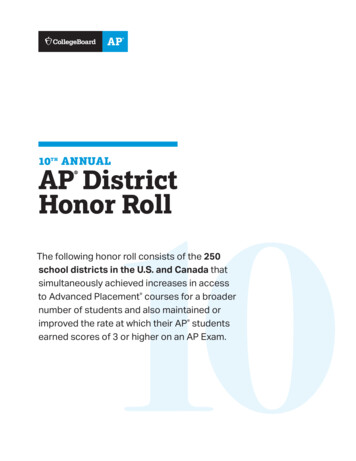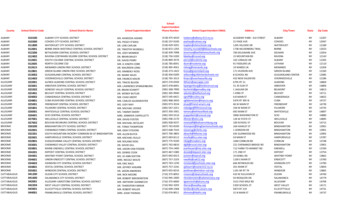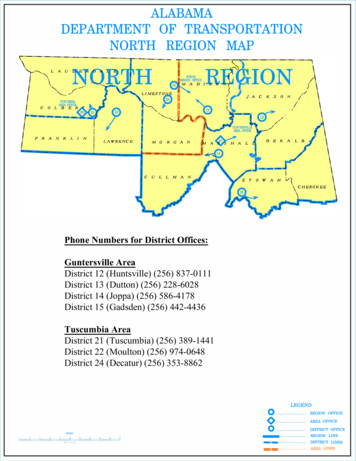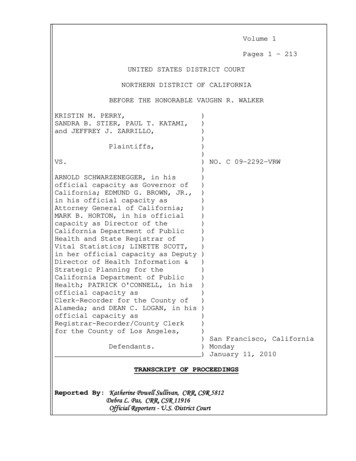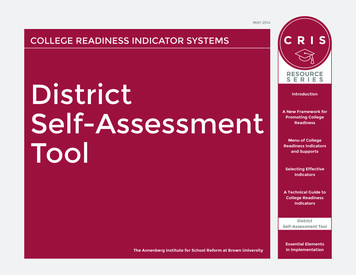
Transcription
College Readiness Indicator Systems DISTRICT SELF-ASSESSMENT TOOL1MAY 2014COLLEGE READINESS INDICATOR SYSTEMSDistrictSelf-AssessmentToolRESOURCES E R I E SIntroductionA New Framework forPromoting CollegeReadinessMenu of CollegeReadiness Indicatorsand SupportsSelecting EffectiveIndicatorsA Technical Guide toCollege ReadinessIndicatorsDistrictSelf-Assessment ToolThe Annenberg Institute for School Reform at Brown UniversityEssential Elementsin Implementation
College Readiness Indicator Systems DISTRICT SELF-ASSESSMENT TOOL2The purpose of the District Self-Assessment Tool is to provide school district and community stakeholders withan approach for assessing district capacity to support a college readiness indicator system and track progressover time. The tool draws on lessons from the collective implementation experiences of the four CollegeReadiness Indicator Systems (CRIS) network sites that are reported in Essential Elements in Implementation, inparticular the following capabilities that are critical to developing a college readiness indicator system:*1. Engaging leadership commitment to a college readiness indicator system2. Building data infrastructure3. Strengthening adult capacity around data use and college readiness4. Connecting indicators with supports to promote college readiness5. Developing partnerships with community institutions and institutions ofhigher educationFor each of these essential elements, we further specify four to six attributes that eachelement comprises. For example, the first element—engaging leadership commitment toa college readiness indicator system—includes the attributes of strategic alignment, thecollege readiness indicator system team, a community-wide vision of college readiness,and strategic communications. The other four elements follow a similar structure. Foreach attribute, we include the following information: the significance of the attributeto a college readiness indicator system, indicators of district capacity in each area, andexamples of promising practice from CRIS sites for each attribute. The assessment toolincludes a checklist that allows the district to estimate current capacity levels for eachattribute (low, medium, or high). Eventually, the tool will link to a database to enable thedistrict and partners to track progress from baseline through implementation.Based on the experience of the Annenberg Institute for School Reform at BrownUniversity (AISR) in facilitating a similar self-assessment process—the CentralOffice Review for Results and Equity (CORRE)—we propose the following processfor implementing the self-assessment (a full implementation guide is currently indevelopment).*The four sites are Dallas Independent School District, New Visions for Public Schools in New York City,Pittsburgh Public Schools, and San Jose Unified School District.1. Form a college readiness indicator system review team. The college readinessindicator system review team includes the district and partner organizationpersonnel who are in the best position to assess the district’s current capacityto design and implement an indicator system: central office leaders, teachers,counselors, principals, community partner representatives, and higher educationrepresentatives.2. Gather initial data. The review team, possibly assisted by an intermediaryorganization, gathers supporting data and existing documentation to prepare forthe launch of the college readiness indicator system review.3. Develop shared understanding of the goal of the process. The review team,in some cases facilitated by the intermediary, formulates a specific focus for thereview based on local circumstances and priorities. The team then sets goals,identifies roles, and establishes a timetable for the review.4. Conduct review using CRIS tools and other guides. The team will use a varietyof data collection techniques to determine the district’s relative level of capacityto design and implement a college readiness indicator system across the essentialelements.5. Analyze data. Data collected in step 4 will be entered into a qualitative dataanalysis application to identify major themes within and across the essentialelements.6. Develop and implement action steps. The review team will examine majorfindings to begin developing an action plan and timeline for implementation.How to cite this document:Annenberg Institute for School Reform, Brown University. (2014). District self-assessment tool. CollegeReadiness Indicator Systems Resource Series. Seattle, WA: Bill & Melinda Gates Foundation.
College Readiness Indicator Systems DISTRICT SELF-ASSESSMENT TOOL31. Engaging Leadership Commitment to a College ReadinessIndicator SystemEffective planning and implementation of a college readiness indicator system requires the sustained commitment ofdistrict and civic leadership. Leaders reinforce the vision that K–12 education should prepare students to succeed incollege and the workplace.Strategic alignmentPositioning a college readiness indicator system as a strategy to advance the district’s overall goals for educational equity promotes stakeholder buy-in, thus reducing thechances that efforts are perceived as “just one more initiative.”INDICATORS OF DISTRICT CAPACITYCURRENT CAPACITY LEVELA clear, compelling definition of college readiness is broadly accepted.LOWMEDIUMHIGHCollege readiness is prominent in the district mission statement.LOWMEDIUMHIGHSpecific goals for implementation of the indicator system are set in the district action plan.LOWMEDIUMHIGHThe budget contains a line-item allocation for implementation of the indicator system.LOWMEDIUMHIGHLeaders reinforce expectations for data use.LOWMEDIUMHIGHThe district commits supports and resources (especially time) for staff to cultivate data competencies.LOWMEDIUMHIGHEfforts are under way to articulate a systemic approach to college readiness.LOWMEDIUMHIGHPromising Practices from CRIS Sites San Jose Unified School District (SJUSD): Opportunity 21 plan. Districtleaders at SJUSD closely aligned CRIS indicators to the objectives ofOpportunity 21, the district’s 2012–17 strategic plan, and its Key PerformanceMeasures, with a focus on measurement and evaluation. New Visions for Public Schools: The 80% goal. College readiness is NewVisions’ primary commitment and its goal is for 80% of its students to graduatefrom high school and enter and succeed in college. New Visions offers toolsfor students, parents, teachers, and administrators to track college readinessbenchmarks from the 9th grade. Dallas Independent School District (DISD): Destination 2020 plan. DISDmade an explicit commitment to career and college readiness in its strategicplan, Destination 2020. The plan states, “By the Year 2020, Dallas will have thehighest college- and career-ready percentage of graduates of any large urbanschool district in the nation.” The plan details specific college- and career-readymetrics for the district to meet, including “80 percent of our students [will]enter college, the military, or a ‘career-ready job’ straight from high school.”
College Readiness Indicator Systems DISTRICT SELF-ASSESSMENT TOOL4The college readiness indicator system teamDeveloping and implementing a college readiness indicator system requires a concerted effort that cuts across district departments to include the expertise of key staff withdifferent roles within the organization. Involvement of senior staff signals leadership commitment to the initiative and facilitates buy-in.INDICATORS OF DISTRICT CAPACITYCURRENT CAPACITY LEVELThe team includes high senior staff from key departments in the central office.LOWMEDIUMHIGHThe team is given significant decisionmaking authority and has clear access to district leadership.LOWMEDIUMHIGHLinkages to schools provide data and technical support.LOWMEDIUMHIGHDiscoveries made by school inquiry teams inform districtwide decisions regarding resources and policy.LOWMEDIUMHIGHThe college readiness indicator system team is seen as the go-to group for analytic support on questions related to collegereadiness.LOWMEDIUMHIGHPromising Practices from CRIS Sites SJUSD: CRIS team. Key senior staff from the areas of data, research andassessment, and curriculum and instruction make up SJUSD’s CRIS team. Stafffrom the information technology department participate in team meetingsas needed. The sustained involvement of one of the assistant superintendentswith the CRIS team gives visibility to the project and positions it as a districtpriority.Community-wide vision of college readinessAn educated workforce is critical to sustain a vibrant local economy. Moreover, the equity-centered goal of college readiness for all students requires a concerted effort toovercome factors that put students of color at a disadvantage. City government, employers, grassroots citizen groups, and other community organizations all have a stake inpromoting college readiness and can play a role in tackling intractable roadblocks to postsecondary education.INDICATORS OF DISTRICT CAPACITYCURRENT CAPACITY LEVELKey community and civic leaders commit to college and career readiness as a community-wide goal.LOWMEDIUMHIGHCritical champions for college readiness emerge inside and outside the system.LOWMEDIUMHIGHCross-sector collaboratives exist to support college and career readiness actions and goals.LOWMEDIUMHIGHPromising Practices from CRIS Sites Pittsburgh Public Schools (PPS): The Pittsburgh Promise. In 2006, the PPSsuperintendent and Pittsburgh’s mayor joined forces to create The PittsburghPromise, a scholarship program designed to help PPS students pursue apostsecondary education and contribute to Pittsburgh’s economic and socialrevitalization. Early results are encouraging and suggest positive impact. SJUSD: Mission statement. SJUSD has tied its college readiness goals to thedistrict’s mission: closing the opportunity gap that limits the futures for manystudents in the district, especially those living in poverty and Latino students.
College Readiness Indicator Systems DISTRICT SELF-ASSESSMENT TOOL5Strategic communicationsOngoing and intentional communication of a clearly defined message around college readiness, both internally and externally, builds awareness of and support for thecollege readiness indicator system initiative.INDICATORS OF DISTRICT CAPACITYCURRENT CAPACITY LEVELDistrict communications emphasize college and career readiness as the driving purpose of K–12 education.LOWMEDIUMHIGHCommunications strategies are in place to promote the college readiness message to both internal and external audiences.LOWMEDIUMHIGHCommunications strategies penetrate the community’s diverse stakeholder groups.LOWMEDIUMHIGHPromising Practice from CRIS Sites PPS: State of the Schools Report. In 2012, PPS released its first State of theSchools report, which provides a public 360-degree view of where schools aresucceeding and where they need to grow via key indicators aligned with thedistrict’s goals. Presented in easy-to-read, school-by-school charts that alsoindicated progress made during the past year, the report included both PromiseReadiness rates and percentage of chronically absent students—a key indicatorof focus in the district’s college readiness work. A corresponding State of theDistrict event was held to help broaden community understanding of thechallenges and opportunities faced by the district.
College Readiness Indicator Systems DISTRICT SELF-ASSESSMENT TOOL62. Building Data InfrastructureThe district has the capacity to generate high-quality, reliable data products to support decisionmaking by schoolpersonnel. Integrated data systems provide actionable and timely data on critical indicators of readiness at the individualstudent level.Integrated data systemsStudent and school information systems (e.g., academic performance, attendance, disciplinary referrals, and survey data) are linked to enable meaningful, real-time data use.INDICATORS OF DISTRICT CAPACITYCURRENT CAPACITY LEVELThe district has a comprehensive and integrated student information system (data warehouse) with the capacity to report on keycollege readiness indicators.LOWMEDIUMHIGHSchool and district staff can generate reports on demand.LOWMEDIUMHIGHPromising Practices from CRIS Sites SJUSD: Partnership with DecisionEd. SJUSD partnered with DecisionEd,a company that provides data and performance management services.DecisionEd’s data warehousing solution consolidates information fromdisparate databases to deliver critical metrics through dashboards andcustomized reports. New Visions: DataCation. New Visions has used DataCation, a comprehensiveweb-based school data management system, since 2010. It has an array oftools for educators, parents, and students to track student progress towardgraduation and college readiness. DataCation supports educators in breakingdown complex student data from diverse sources to inform and supportinstruction, professional development, curriculum planning, and accountabilityand policy. New Visions assumes the cost of providing DataCation to itsnetwork, although as a third-party vendor, DataCation is available to schoolsand districts nationwide for a fee.
College Readiness Indicator Systems DISTRICT SELF-ASSESSMENT TOOL7Data qualityThe results of any data analysis efforts are only as good as the quality of the data. Evidence-based decisionmaking becomes compromised in the absence of accurate data.INDICATORS OF DISTRICT CAPACITYCURRENT CAPACITY LEVELQuality-control procedures are in place to validate the reliability of system data.LOWMEDIUMHIGHSchool and district staff voice confidence in the reliability of data.LOWMEDIUMHIGHThe district takes measures to address data quality issues when they emerge.LOWMEDIUMHIGHPromising Practices from CRIS Sites PPS: Student attendance initiative. In adopting student attendance as one ofthe district’s academic tenacity indicators and in recognition that attendanceis tracked in a different fashion at different schools, PPS is developing clearguidelines to bring consistency to the collection of attendance data. New Visions: DataCation gradebook. The DataCation system used by NewVisions is driven by its gradebook function, one of the most relevant toolsfor teachers. Teachers were front and center in the design of the DataCationplatform and continue to provide ongoing feedback about ease of use andalignment with their day-to-day work, thus enhancing data quality.Data toolsData tools must align with users’ natural workflow to lead to widespread adoption.INDICATORS OF DISTRICT CAPACITYCURRENT CAPACITY LEVELTeachers are involved in the design and testing of reporting formats.LOWMEDIUMHIGHData tools are useable to teachers in the “regular flow” of responsibilities.LOWMEDIUMHIGHData tools are not viewed as an unreasonable burden on staff.LOWMEDIUMHIGHMetrics are displayed in accessible formats like dashboards.LOWMEDIUMHIGHPromising Practices from CRIS Sites New Visions: Google Scripts. DataCation’s gradebook function, which allowsteachers to calculate and store grade information, blends with the naturalflow of teacher’s work and provides real-time access to data. New Visionshas adopted a Google platform, Scripts, to provide teachers a customized,automated workbook for core elements such as attendance. Parents are sent anautomated email or text message when a student misses a class. DISD: College-ready report cards. DISD uses a database that enables thedirector of counseling to generate “college-ready report cards” for campuscounselors and parents. These report cards show schools’ status regardingthe district goals around college readiness (e.g., Free Application for FederalStudent Aid [FAFSA] completion).
College Readiness Indicator Systems DISTRICT SELF-ASSESSMENT TOOL8School–central office data collaborationMany districts have Balkanized information systems and organizational structures that limit the effective use of data. Reform efforts that promote organizationalcommunication and collaboration can help facilitate data sharing, joint decisionmaking, and shared vision toward a college readiness indicator system.INDICATORS OF DISTRICT CAPACITYCURRENT CAPACITY LEVELMechanisms exist that promote data collaboration between central office staff and schools.LOWMEDIUMHIGHSchool and central office staff to facilitate data collaboration are designated.LOWMEDIUMHIGHSchool-based discoveries are used by central office staff to inform broader changes in policy, resources, system supports, etc.LOWMEDIUMHIGHSchool staff feel authorized to propose changes to the indicator system to central office colleagues.LOWMEDIUMHIGHPromising Practices from CRIS Sites PPS: Lead data analyst and strategic data fellows. PPS has hired a dataconsultant with extensive experience creating integrated information systemsthat help disaggregate data by subgroups, along with three strategic datafellows. The data consultant has interviewed and brought together central officemanagers and staff to understand reporting priorities and develop plans fordata governance. New Visions: DataCation. The DataCation system used by New Visionssupports the different levels of data aggregation linked to educators’ differentroles.Access to postsecondary dataData sharing between K–12 and higher education systems enables analysis of the adequacy of K–12 college readiness supports in preparing students for postsecondarysuccess.INDICATORS OF DISTRICT CAPACITYCURRENT CAPACITY LEVELData-sharing agreements support exchange of information between districts, colleges, and labor market sources.LOWMEDIUMHIGHDistricts and colleges respond to the shared data.LOWMEDIUMHIGHA forum exists for districts and colleges to track students’ academic success.LOWMEDIUMHIGHPromising Practice from CRIS Sites All CRIS Sites: National Student Clearinghouse (NSC) StudentTracker. AllCRIS sites elect to participate in the NSC’s StudentTracker for High Schoolservice for the purpose of examining the relationship between K–12 outcomesand postsecondary enrollment and completion. The StudentTracker for HighSchool online research service offers real-time, accurate data on studenteducational outcomes throughout higher education in the United States.
College Readiness Indicator Systems DISTRICT SELF-ASSESSMENT TOOL9Teacher leadership in designing the college readiness indicator systemIncorporation of teachers’ perspectives increases the likelihood that the system will generate relevant, accurate, and timely information that will be used by those workingclosest to students.INDICATORS OF DISTRICT CAPACITYCURRENT CAPACITY LEVELTeachers are involved in the planning and rollout of the college readiness indicator system.LOWMEDIUMHIGHTeachers advise on ongoing implementation of the college readiness indicator system, including midcourse corrections.LOWMEDIUMHIGHTeachers advise on the selection of key indicators for the Cycle of Inquiry.LOWMEDIUMHIGHTeachers participate in the Cycle of Inquiry at all levels of the system (schools and district).LOWMEDIUMHIGHPromising Practices from CRIS Sites SJUSD: Teachers advised on indicator selection and participate in the Cycleof Inquiry. A set of school administrators and teachers were actively involvedin selecting SJUSD’s college readiness indicators and articulation of cycles ofinquiry. Teachers are also part of teams known as OPSTAT (see StrengtheningAdult Capacity section) that focus on the articulation of each of the district’sKey Performance Measures. New Visions: Teachers assisted in DataCation design. Teachers had a crucialrole in the design of DataCation, New Visions’ student information system, andprovide ongoing feedback about ways in which it could be improved. Also, theorganization’s Teacher Effectiveness Inquiry Team accesses data needed withinNew Visions’ warehouse to support process monitoring and identify datacollection gaps.
College Readiness Indicator Systems DISTRICT SELF-ASSESSMENT TOOL103. Strengthening Adult CapacityTo promote continued gains in college readiness, districts should pair their investment in data systems with aninvestment in enhancing the capacity of adults—both at the district and school levels—to use data to help improveclassroom practice, increase learning, track college readiness, and apply appropriate interventions. Building adultcapacity around data use includes improving knowledge of how to access, collect, filter, organize, manage, and probedata in a systematic way and act upon results in a timely manner. Thus, in a concerted effort to prepare graduates tosucceed in college, a high-functioning system invests in supports for both students and its professional educators.Many CRIS sites also provide parents with access to relevant data and include them in capacity-building efforts arounddata use through targeted outreach. These efforts focus on interpreting the attendance, grade, course-taking, and othercollege readiness data available from the school.Time for collaborative data analysisCreating regular opportunities for educators at all levels of the system to engage in a collaborative inquiry process to improve their expertise and experience in thetechnical, organizational, and substantive aspects of data use helps ensure data are not just available but applied effectively.INDICATORS OF DISTRICT CAPACITYCURRENT CAPACITY LEVELSchool-based and central office data teams meet regularly to review patterns in the data that improve targeting of resources tostudents, schools, and the broader system.LOWMEDIUMHIGHA functional line of communication exists between the central office and the schools that enables them to learn from each other.LOWMEDIUMHIGHEfforts are made to articulate data use across grade levels, especially between middle schools and the high schools into which theyfeed.LOWMEDIUMHIGHThe district shares regular waves of data with school leadership, especially principals.LOWMEDIUMHIGHPromising Practices from CRIS Sites SJUSD: Feeder-pattern pilot. A feeder pattern of three schools pilotingthe indicator system has a data team in place that meets regularly to discussprogress on the implementation of their selected college readiness indicators. Amember of the central office CRIS team attends these meetings to ensure thatcollege readiness efforts align across schools and to serve as liaison betweenschool staff and district leadership. SJUSD: Districtwide data team. In addition, SJUSD established OPSTAT(“OP” for Opportunity 21, the name of the district’s strategic plan, and “STAT”for statistics and its data-driven nature) working groups that meet two tosix times a year. Each OPSTAT team focuses on one of the district’s KeyPerformance Measures. DISD: Principal engagement. DISD executive directors of strategic feederpatterns lead regular group meetings with principals to review their schools’data on key academic indicators. Principals rotate presenting their data to theirpeers and executive directors using a standardized PowerPoint and a protocolfor peers to ask questions. Data from key points during the school year (e.g.,the six-week mark after school begins) are examined for intervention purposes.
College Readiness Indicator Systems DISTRICT SELF-ASSESSMENT TOOL11Designating a school-based data facilitatorWith the targeted support of a data facilitator, school leadership and teachers can develop their own skills in data inquiry.INDICATORS OF DISTRICT CAPACITYCURRENT CAPACITY LEVELA significant portion of school-based personnel facilitates report generation and data use.LOWMEDIUMHIGHCentral office or regional staff support and train school-based data specialists.LOWMEDIUMHIGHThe district fosters support of building principals for the commitment of resources to support data use and training.LOWMEDIUMHIGHPromising Practices from CRIS Sites New Visions: Leadership development facilitators (LDFs). Theseprofessionals provide intensive on-site coaching to the school inquiry team.LDFs support inquiry teams in the process of examining student data; selectinga target population; and developing, testing, and refining strategies to improvethe achievement of that population. DISD: Data coaches. DISD hired data coaches who worked with school-leveleducators (particularly principals) on capacity building around data providedby the central office. These coaches were supervised at the district level butspent the majority of their time in schools.Support for the use of data through professional developmentProfessional development ensures that educators are able to collect, access, and analyze data to improve instruction, monitor student achievement, and provideappropriate interventions.INDICATORS OF DISTRICT CAPACITYCURRENT CAPACITY LEVELStaff at all levels receive dedicated, job-embedded professional development in the area of data use.LOWMEDIUMHIGHTraining in data quality control is provided to staff responsible for data collection and management.LOWMEDIUMHIGHProfessional development staff offer customized data training modules for staff at varying levels of data expertise.LOWMEDIUMHIGHPromising Practice from CRIS Sites New Visions: DataCation. The 2010 launch of New Visions’ customized webbased student information system, DataCation, was accompanied by intensivestaff training. In the two years following the system’s adoption, New Visionsdelivered more than 260 trainings that reached almost 3,000 educators.
College Readiness Indicator Systems DISTRICT SELF-ASSESSMENT TOOL12Providing opportunities for school leaders to learn from one anotherColleagues dealing with similar challenges and experiences in different settings make valuable learning partners.INDICATORS OF DISTRICT CAPACITYCURRENT CAPACITY LEVELWorkshops and other learning opportunities exist for staff to share practice and jointly problem solve.LOWMEDIUMHIGHTeacher, counselor, and principal networks exist for regular interaction around data in role-alike formats.LOWMEDIUMHIGHPromising Practice from CRIS Sites New Visions: Critical Friends Groups. New Visions designs and facilitatesCritical Friends Groups for all principals in their school networks (by gradelevel, location, or school type). The most advanced groups studied schooldata extensively and engaged in visits to learn about each other’s systems andpractice.Providing opportunities for teachers to acquire knowledge and skills to support students in applying to andgetting ready for collegeTeachers can be critical conduits of college knowledge, as many have built trust with their students and can make important connections between college knowledge andthe curricula they use to teach in high school.INDICATORS OF DISTRICT CAPACITYCURRENT CAPACITY LEVELTeachers are actively encouraged, involved in, and acknowledged for supporting their students’ college selection and applicationprocess.LOWMEDIUMHIGHThe district offers informational resources to teachers in their role as college advisers, including the latest research on keycomponents of college knowledge and the importance of a strong college match.LOWMEDIUMHIGHPromising Practices from CRIS Sites DISD: SAT training. DISD trains teachers across different high schoolcampuses to help students prepare for the SAT exam. PPS: Pittsburgh Promise readiness supports. PPS, in partnership with thePittsburgh Promise, provides students and families with information andcampus visits to help orient them to college campus life. New Visions: College knowledge guidance. New Visions provides all highschool teachers with information about college options, application procedures,and other relevant college knowledge.
College Readiness Indicator Systems DISTRICT SELF-ASSESSMENT TOOL13Providing parents with information about academic prerequisites for college, the application process, andfinancial aidMany parents do not have experience with higher education or they come from countries with different educational systems. Giving them access to key information abouthow to prepare for and apply to college helps clear misconceptions (e.g., college is too expensive or family cannot afford it) and allows them to best support their children inmeeting their postsecondary aspirations.INDICATORS OF DISTRICT CAPACITYCURRENT CAPACITY LEVELThe district has reliable, multimedia mechanisms for communicating with parents, especially parents of high school students, onthe key academic requirements of college admission.LOWMEDIUMHIGHParents have ready access to the real-time academic standing of their children.LOWMEDIUMHIGHDistrict and community supports exist to help parents navigate through the college selection, application, and financial aidprocesses.LOWMEDIUMHIGHPromising Practices from CRIS Sites DISD: Parent University. The Parent University helps parents at all levelsunderstand the steps in getting ready for and applying to college. Workshopsare offered on a variety of topics including financial aid and SAT/ACTpreparation. This program will integrate current activities in which counselorseducate students about scholarships and host college nights to educate parentsand students about the FAFSA. Counselors target their outreach based on theFAFSA completion rate at schools and individual FAFSA filing data. New Visions: “Eleventh Grade: The College Application Process StartsHere!” This process engages parents of 9th graders early on to make sure theyknow what students must do to stay on track. They share information viaongoing bilingual workshops and parent-centered publications. New Visionsprovides parents of 11th graders with a detailed listing of application andfinancial aid requirements and resources and important dates and benchmarksin the college application process. PPS: College-ready reports. Parents and teachers receive data reports fromthe central office data team on the Promise Ready status of their students.For those who are off-track for College Ready eligibility, the reports indicatethe magnitude of improvement
College Readiness Indicator Systems DISTRICT SELF-ASSESSMENT TOOL 2 *The four sites are Dallas Independent School District, New Visions for Public Schools in New York City, Pittsburgh Public Schools, and San Jose Unified School District. How to cite this document: Annenberg Institute for School Reform, Brown University. (2014).





